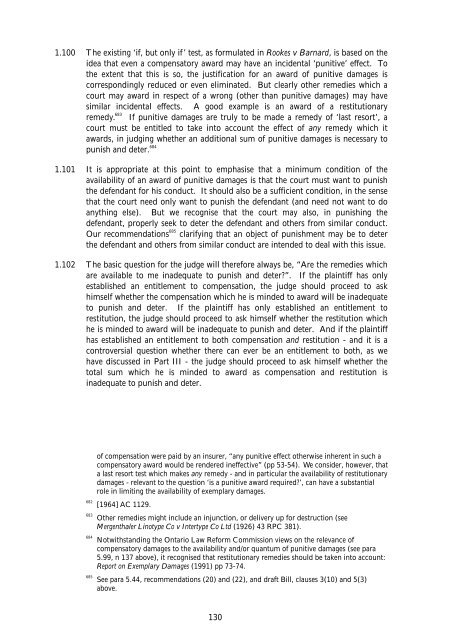Aggravated, Exemplary and Restitutionary ... - Law Commission
Aggravated, Exemplary and Restitutionary ... - Law Commission
Aggravated, Exemplary and Restitutionary ... - Law Commission
Create successful ePaper yourself
Turn your PDF publications into a flip-book with our unique Google optimized e-Paper software.
1.100 The existing ‘if, but only if’ test, as formulated in Rookes v Barnard, is based on the<br />
idea that even a compensatory award may have an incidental ‘punitive’ effect. To<br />
the extent that this is so, the justification for an award of punitive damages is<br />
correspondingly reduced or even eliminated. But clearly other remedies which a<br />
court may award in respect of a wrong (other than punitive damages) may have<br />
similar incidental effects. A good example is an award of a restitutionary<br />
remedy. 683<br />
If punitive damages are truly to be made a remedy of ‘last resort’, a<br />
court must be entitled to take into account the effect of any remedy which it<br />
awards, in judging whether an additional sum of punitive damages is necessary to<br />
punish <strong>and</strong> deter. 684<br />
1.101 It is appropriate at this point to emphasise that a minimum condition of the<br />
availability of an award of punitive damages is that the court must want to punish<br />
the defendant for his conduct. It should also be a sufficient condition, in the sense<br />
that the court need only want to punish the defendant (<strong>and</strong> need not want to do<br />
anything else). But we recognise that the court may also, in punishing the<br />
defendant, properly seek to deter the defendant <strong>and</strong> others from similar conduct.<br />
Our recommendations 685<br />
clarifying that an object of punishment may be to deter<br />
the defendant <strong>and</strong> others from similar conduct are intended to deal with this issue.<br />
1.102 The basic question for the judge will therefore always be, “Are the remedies which<br />
are available to me inadequate to punish <strong>and</strong> deter?”. If the plaintiff has only<br />
established an entitlement to compensation, the judge should proceed to ask<br />
himself whether the compensation which he is minded to award will be inadequate<br />
to punish <strong>and</strong> deter. If the plaintiff has only established an entitlement to<br />
restitution, the judge should proceed to ask himself whether the restitution which<br />
he is minded to award will be inadequate to punish <strong>and</strong> deter. And if the plaintiff<br />
has established an entitlement to both compensation <strong>and</strong> restitution - <strong>and</strong> it is a<br />
controversial question whether there can ever be an entitlement to both, as we<br />
have discussed in Part III - the judge should proceed to ask himself whether the<br />
total sum which he is minded to award as compensation <strong>and</strong> restitution is<br />
inadequate to punish <strong>and</strong> deter.<br />
of compensation were paid by an insurer, “any punitive effect otherwise inherent in such a<br />
compensatory award would be rendered ineffective” (pp 53-54). We consider, however, that<br />
a last resort test which makes any remedy - <strong>and</strong> in particular the availability of restitutionary<br />
damages - relevant to the question ‘is a punitive award required?’, can have a substantial<br />
role in limiting the availability of exemplary damages.<br />
682 [1964] AC 1129.<br />
683 Other remedies might include an injunction, or delivery up for destruction (see<br />
Mergenthaler Linotype Co v Intertype Co Ltd (1926) 43 RPC 381).<br />
684 Notwithst<strong>and</strong>ing the Ontario <strong>Law</strong> Reform <strong>Commission</strong> views on the relevance of<br />
compensatory damages to the availability <strong>and</strong>/or quantum of punitive damages (see para<br />
5.99, n 137 above), it recognised that restitutionary remedies should be taken into account:<br />
Report on <strong>Exemplary</strong> Damages (1991) pp 73-74.<br />
685 See para 5.44, recommendations (20) <strong>and</strong> (22), <strong>and</strong> draft Bill, clauses 3(10) <strong>and</strong> 5(3)<br />
above.<br />
130
















